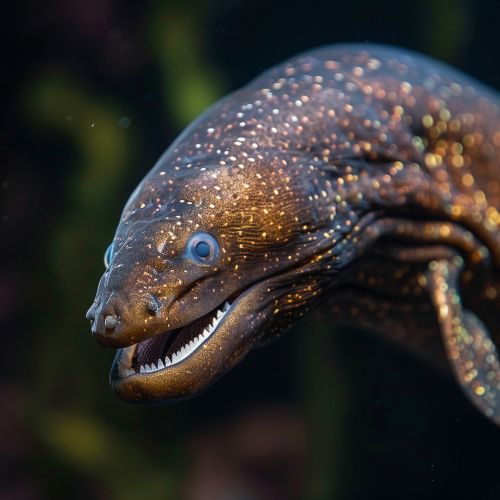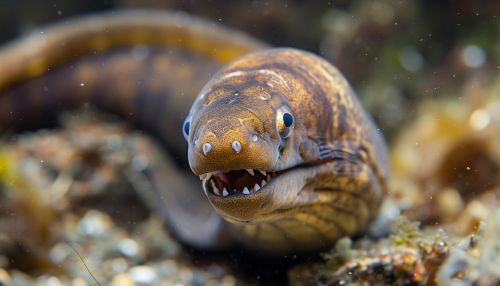Eel
Taxonomy and Species
Eels are ray-finned fish that belong to the order Anguilliformes, which consists of four suborders, 20 families, 111 genera and about 800 species. Most eels are predators and have a snake-like body. The term "eel" is also used for some other similarly shaped fish, such as electric eels and spiny eels, but these are not members of the Anguilliformes order.
Anatomy and Morphology
Eels' bodies are elongated, cylindrical and covered with slimy mucus, which allows them to move easily through their aquatic environments. They have no pelvic fins, and many species also lack pectoral fins. The dorsal and anal fins are fused with the caudal or tail fin, forming a single ribbon running along much of the length of the animal. Eels' scales are small and embedded in the skin, creating a smooth texture.


Physiology
Eels have a number of physiological adaptations that allow them to thrive in a variety of aquatic environments. For example, their small, sharp teeth are well-suited for catching and holding onto prey. Eels also have a highly developed sense of smell, which they use to locate food and navigate their environment. Some species of eels, such as the electric eel, are capable of generating electric shocks, which they use for hunting and self-defense.
Life Cycle
Eels have a complex life cycle that includes several distinct stages. They begin their lives as eggs, which are fertilized externally in the water. After hatching, the larvae, known as leptocephali, drift in the open ocean for several months or even years. During this time, they undergo a series of transformations before finally becoming glass eels, which are transparent and have the elongated shape of adult eels. Glass eels eventually migrate to fresh or brackish water, where they mature into adults and eventually reproduce.
Distribution and Habitat
Eels are found in a wide range of habitats, from freshwater rivers and lakes to deep-sea environments. They are particularly abundant in the Atlantic and Pacific Oceans, but can also be found in the Indian Ocean and the Mediterranean and Caribbean Seas. Some species, such as the European eel and the American eel, undertake long-distance migrations between their freshwater habitats and their spawning grounds in the ocean.
Diet and Predation
Eels are carnivorous, feeding on a variety of prey including fish, crustaceans, and various invertebrates. Their diet varies depending on their size and habitat. Eels themselves are preyed upon by a variety of predators, including larger fish, birds, and mammals.
Relationship with Humans
Eels have a complex relationship with humans. They have been valued as a food source for thousands of years, and eel fishing remains a significant industry in many parts of the world. However, eel populations have been declining due to overfishing, habitat loss, and other human impacts. Conservation efforts are underway to protect and restore eel populations.
